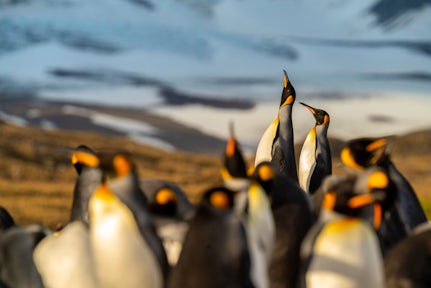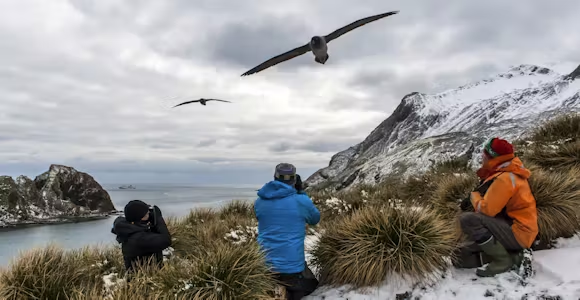
St Andrews Bay
Even on an island that abounds with incredible wildlife encounters, the vast king penguin colony of St Andrews Bay is truly something special.
Discover More
King penguin and male fur seal at Salisbury Plain
King penguins are without doubt the rockstars of South Georgia. Indeed, when you hear the noise that a colony of tens of thousands of them makes you might almost imagine that you're in the middle of some deafening wildlife music festival.
Standing just under a metre tall with their smart grey suits, black heads punctuated with large gold commas and salmon bills, kings are also one of the handsomest penguin species. South Georgia is home to around 450,000 pairs of them, or somewhere between a third and half the world's population. They're a sub-Antarctic species which means that you won't find them on the Antarctic Peninsula, though smaller numbers also breed on the Falkland Islands, so expedition cruises to the region normally offer two chances of seeing them.
Unlike most penguin species, kings don't make nests but incubate their eggs under a flap of skin above the feet: if you see a penguin that looks like it's shuffling along on its heels, it's sure to be incubating an egg. Chicks take around 14 months to raise, which means that the penguins breed twice every three years, with birds divided into early- and late season breeders. For the visitor, this unusual breeding cycle means that whatever time you visit you'll always see plenty of outrageously fluffy chicks as well as adult birds.

King penguins in the early morning at St Andrews Bay
King penguins are found across South Georgia, but the big-ticket colonies are undoubtedly those at St Andrews Bay, Salisbury Plain and Gold Harbour. St Andrews Bay alone is home to perhaps a quarter of a million king penguins.
When visiting a king penguin colony there's a strong temptation to head straight for the main action, but spending time on the beach is also highly recommended. There will be rafts of penguin swimming or porpoising through the waves, and a constant traffic of penguins in and out of the sea. King penguins easily range over several hundred kilometres in search of their favoured diet of squid, lantern fish and krill, diving 300m below the surface for the tastiest prey. If you wonder why they pause to catch breath and investigate the people landing in zodiacs on their beaches, when they come ashore, remember they've been travelling nearly as far as you have to get there.

Macaroni penguins at Cooper Bay
Macaroni penguins are one of most exuberantly dressed of all the penguin species. Standing around 70cm tall, they're immediately recognisable from a distance thanks to their brilliant yellow crest that acts like a set of comic eyebrows above their burnt orange beak. Pink feet set off the ensemble. There are more macaroni penguins on South Georgia than any other penguin species, although ironically they're often the last that visitors see. This is due to their breeding habits, as these birds nest on cliffs, happily ignoring their flightless nature to hop up steep rock faces with great determination thanks to the crampon-like claws on their feet.
Macaronis always lay two eggs, but only raise the chick from the second egg: the first egg is around 40% smaller than the viable second and is always discarded. The reasons for this behaviour still remain unknown.
Cooper Bay is the only landing site on the island where it's possible to observe a macaroni colony on foot; zodiac cruises around the steep cliffs of Elsehul are another great place to see them, along with the large numbers of albatross nesting there.
Macaroni penguins are sometimes mixed up with the similar but slightly smaller rockhopper penguin, which isn't found on South Georgia but breeds in large numbers on the Falkland Islands.

Gentoo penguin in the tussac grass at Godthul
Gentoo penguins are most commonly associated with the Antarctic Peninsula (visitors there will rarely fail to see them in large numbers), but South Georgia is home to around 105,000 breeding pairs. They stand around 60cm tall and have a distinctive white patch that wraps itself around the crown of their heads like a set of earmuffs, along with bright orange bills.
Gentoos penguins are like their macaroni cousins in favouring a krill-rich diet, but when it comes to choosing somewhere to breed, they eschew South Georgia's exposed cliffs and prefer the relative cosiness found by heading inland on the most sheltered bays. Nests are made among the tussac grass, where the plentiful vegetation and mud form the perfect building material and remove the need for the pebble-stealing behaviour commonly seen among nesting gentoos on the Antarctic peninsula. Two chicks are commonly raised.
Stromness Harbour, Godthul and Gold Harbour are all good places to spot gentoo penguins in their colonies, although itinerant birds often pop up on the beach at many landing sites, where it's not uncommon to see them porpoising through the water.

A chinstrap penguin among the macaronis at Godthul.
Fewer than 14,000 pairs of chinstrap penguins breed on South Georgia. They are really a cold climate species, so they are mainly found at the cooler southern tip of the island; South Georgia forms the northernmost limit of their range.
Typically standing around 70cm tall, chinstraps take their name from the thin black line running under the chin. Pebbles are their preferred nesting material and two chicks are typically raised.
While there is a chance of spotting itinerant chinstrap penguins on any beach in South Georgia, Cooper Bay is the only landing site that is home to a colony. Although it is possible to land elsewhere in the bay, access to the chinstrap colony is by zodiac cruise only. Chinstraps on South Georgia are really harbingers of the great white south: sightings are not uncommon as your ship crosses the Scotia Sea towards the Antarctica Peninsula. Icebergs frequently carry chinstrap passengers, while there is a large colony at Point Wild on Elephant Island.
Price Match Promise - We’ll match any price you find elsewhere for the same trip

Even on an island that abounds with incredible wildlife encounters, the vast king penguin colony of St Andrews Bay is truly something special.
Discover More
Godthul offers three key South Georgia experiences in one location: penguins, a brush with its whaling history and hiking into the hills for arresting views.
Discover More
The beautiful natural harbour of Elsehul is one of the most stunning locations in South Georgia, and has some of the best bird watching on the entire island.
Discover More
Kings, macaronis, gentoos and chinstraps: Cooper Bay is one of the only places in South Georgia where all four of its penguin species can be spotted.
Discover MoreWe'll spend some time listening to your aspirations, then discuss the kind of experience that might suit you.
Next we'll discuss the options, shortlist the best trips for you and present you our impartial recommendations.
We'll place a 24 hour hold on your preferred option - without obligation - whilst we talk through the details.